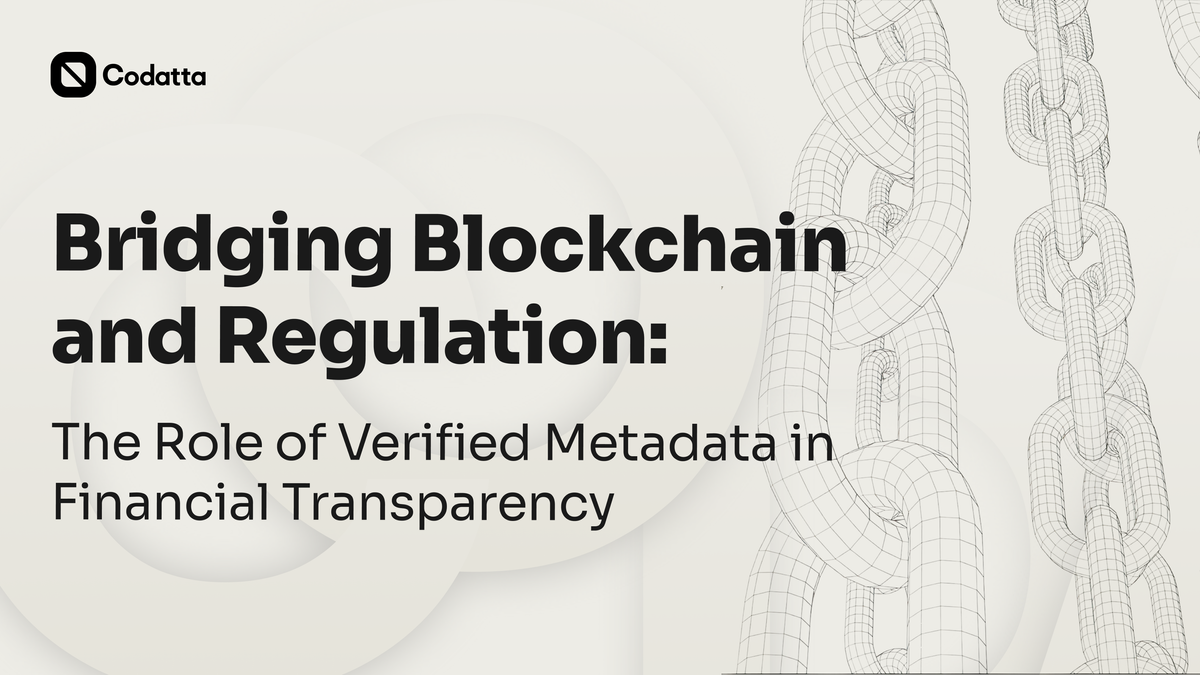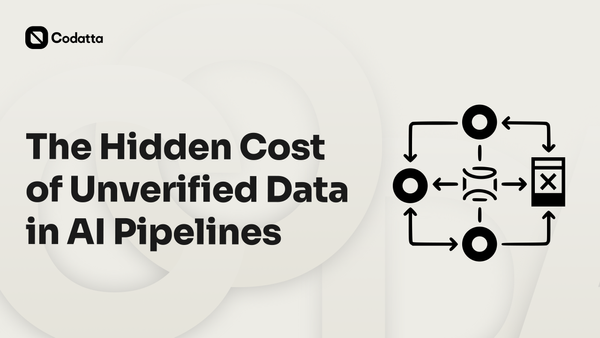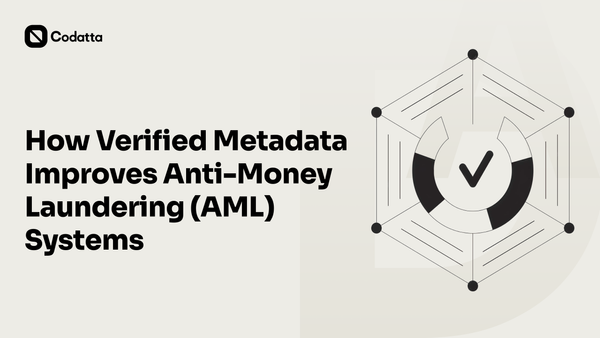Bridging Blockchain and Regulation: The Role of Verified Metadata in Financial Transparency

Blockchain technologies have transformed how financial systems record and verify information. Every blockchain transaction leaves a traceable record on a distributed ledger, creating an environment where transparency and accountability are built into the system itself. Financial institutions are exploring the use of blockchain technology to enhance reporting, improve audit trails, and reduce data manipulation across the financial sector.
Global regulators are now aligning with this direction. Frameworks such as the OECD’s Global Blockchain Policy Centre, FATF’s Travel Rule, and the EU MiCA regulation all emphasize the need for verifiable records that can support transparent financial services and compliance oversight. These standards aim to bring digital asset markets closer to the same accountability expected in traditional financial systems.
The challenge is that much of today’s blockchain data lacks standardized metadata. Transactions may be transparent, yet without structured context, they remain difficult for auditors and regulators to interpret. This gap limits the full adoption of blockchain applications in financial reporting and compliance workflows.
Read on to see how verified metadata can align decentralized finance with the needs of global regulation, strengthening trust across the entire blockchain ecosystem.
The Challenge: Fragmented Data and Regulatory Blind Spots
Unstructured blockchain data still complicates financial reporting, AML reviews, and audit procedures. A blockchain network can record every financial transaction, yet without standardized metadata on intent, ownership, and source, regulators and financial institutions struggle to interpret records across a distributed ledger. The result is slow reconciliation and a higher compliance burden in any application of blockchain technology.
The Financial Action Task Force (FATF) reports that many jurisdictions continue to lag on Travel Rule implementation and consistent attribution for virtual asset activity, which limits traceability in a blockchain system and weakens oversight of financial data.
The Bank for International Settlements (BIS) notes ongoing challenges in turning raw records on distributed ledger technologies into audit-ready information for supervision and AML compliance — an adoption hurdle for financial institutions using blockchain.
Independent analysis from RUSI highlights data-verification gaps in virtual-asset ecosystems that delay sectoral risk assessments and cross-border supervision, creating blind spots for regulators assessing the adoption of blockchain technology in the financial sector.
Until blockchain applications carry verified and standardized metadata, auditors will keep spending more time reconstructing context instead of testing controls. That raises compliance costs and slows institutional adoption of using blockchain at scale, even as the technology promises enhanced transparency for the financial system.
The Missing Link: Verified Metadata
Verified metadata means structured and traceable information that includes proof of validation and contributor accountability. Each record shows who confirmed it, when it was verified, and under what criteria. This context turns a raw blockchain transaction into something the financial industry can interpret with accuracy and confidence.
Studies published through the OECD Global Blockchain Policy Centre and the FATF’s Travel Rule guidance explain that transparent data standards are essential for integrating blockchain into regulated financial systems. Without those standards, the use of blockchain technology remains limited to isolated applications, disconnected from formal compliance and oversight processes.
When verified metadata is attached to every on-chain transaction, auditors and regulators can identify intent, ownership, and data origin without manual reconstruction. It allows financial institutions to integrate blockchain into their existing reporting systems while preserving enhanced security and auditability.
A growing body of research, including systematic literature reviews on the integration of blockchain in financial services, supports this approach as a practical way to align decentralized technology with traditional data standards. Verified metadata provides the trust layer that links distributed systems to established frameworks, helping the financial industry build transparency, accountability, and lasting value based on blockchain technology.
How Codatta Bridges Blockchain and Regulation
Codatta strengthens the connection between blockchain technology and financial regulation through a decentralized data protocol built for validation and provenance tracking. The system creates trust in blockchain records without interfering with the transactions themselves. Instead of processing or storing financial activities, it focuses on structuring and verifying the metadata that surrounds them.
Every verified entry in Codatta includes proof of validation, contributor reputation, and traceable lineage. This helps banks and other financial institutions confirm the accuracy of blockchain and digital records when evaluating compliance, AML, or KYC requirements. Regulators and auditors can review transaction data through a standardized, transparent framework that reveals how information was verified and when.
Using blockchain technology in this way enhances oversight without sacrificing security or privacy. Codatta’s protocol ensures that verified metadata remains interoperable across different blockchain systems, compliance tools, and financial services platforms. This structure helps address the persistent challenge of financial crimes and data inconsistency in digital finance, turning the potential of blockchain into a reliable tool for regulatory confidence and transparency.
Real-World Applications
Verified metadata brings measurable improvements to real use cases across the financial sector.
In AML and KYC, validated blockchain records help institutions detect unusual transactions with greater precision. Each entry carries contextual data that confirms who verified it, when, and under what standard. This improves the accuracy of suspicious activity reporting and strengthens oversight in financial products that employ blockchain for compliance monitoring. Reports by the Financial Action Task Force (FATF, 2024) emphasize that traceable and standardized blockchain data enhances transparency and supports global AML frameworks.
In stablecoins and decentralized finance (DeFi), verified metadata allows projects to align with MiCA and FATF requirements for asset backing and transaction traceability. Blockchain integration with verifiable metadata helps issuers and exchanges publish transparent reserves and operational data that regulators can audit. The European Union’s MiCA regulation highlights that employing blockchain for disclosure, paired with verifiable records, can improve accountability in the context of blockchain-based financial systems.
For institutional blockchain adoption, standardized metadata simplifies audit processes. Financial institutions, banks, and oversight bodies can access structured, machine-readable transaction data without manual reconciliation. This feature of blockchain technology enhances efficiency and reduces compliance costs across distributed ledgers. The analysis of blockchain reporting practices by the Bank for International Settlements (BIS, 2024) confirms that institutions adopting transparent validation frameworks experience higher data reliability and faster verification cycles.
Verified metadata transforms blockchain from a tool of innovation into an instrument of trust. It turns complex blockchain networks into transparent systems that regulators, auditors, and enterprises can use with confidence across traditional and decentralized finance.
Conclusion: Building Trust Through Verified Data
Transparent and verified metadata creates accountability in financial systems and helps reduce friction between innovation and regulation. It strengthens the integrity of blockchain technology in financial environments, where reliable data is key to preventing financial fraud and meeting global reporting standards.
Codatta serves as a bridge that connects decentralized networks with traditional compliance systems. Its structure brings verified provenance into the blockchain ecosystem, allowing regulators and financial institutions to interpret blockchain records with greater confidence.
As emerging technologies continue to shape the future of finance, verified metadata will help institutions adopt blockchain technology responsibly. It will turn distributed networks into transparent, auditable systems that preserve the advantages of blockchain while aligning with the expectations of modern oversight.




